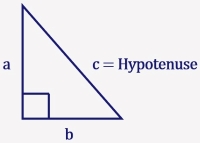
- { a }^{ 2 }+{ b }^{ 2 }={ c }^{ 2 }
- Given a right triangle, the sum of the squares of the side lengths of { a } and { b }, is equal to the square of side { c }, which is called the Hypotenuse.
- Application: Determining the length of a side of a right triangle given the length of the other two sides of the same right triangle.
- Application: Verifying that a triangle is a right triangle given all side lengths of that triangle.
- Application: Derivation of the Distance Formula
In mathematics, the Pythagorean theorem or Pythagoras' theorem is a fundamental relation in Euclidean geometry between the three sides of a right triangle. It states that the area of the square whose side is the hypotenuse (the side opposite the right angle) is equal to the sum of the areas of the squares on the other two sides. This theorem can be written as an equation relating the lengths of the sides a, b and the hypotenuse c, often called the Pythagorean equation:
 | |
| Type | Theorem |
|---|---|
| Field | Euclidean geometry |
| Statement | The sum of the areas of the two squares on the legs (a and b) equals the area of the square on the hypotenuse (c). |
| Symbolic statement |  |
| Generalizations | |
| Consequences | |
The theorem is named for the Greek philosopher Pythagoras, born around 570 BC. The theorem has been proven numerous times by many different methods – possibly the most for any mathematical theorem. The proofs are diverse, including both geometric proofs and algebraic proofs, with some dating back thousands of years.
When Euclidean space is represented by a Cartesian coordinate system in analytic geometry, Euclidean distance satisfies the Pythagorean relation: the squared distance between two points equals the sum of squares of the difference in each coordinate between the points.
The theorem can be generalized in various ways: to higher-dimensional spaces, to spaces that are not Euclidean, to objects that are not right triangles, and to objects that are not triangles at all but n-dimensional solids. The Pythagorean theorem has attracted interest outside mathematics as a symbol of mathematical abstruseness, mystique, or intellectual power; popular references in literature, plays, musicals, songs, stamps, and cartoons abound.

